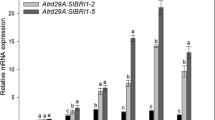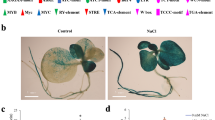Abstract
Although accumulating evidence points to the essential roles of nucleus-encoded chloroplast S1 domain-containing proteins (SDPs) in chloroplast RNA metabolism and plant development, functions of chloroplast SDPs in abiotic stress responses are largely unknown. In this study, we investigated the role of a SDP (At1g12800) in Arabidopsis response to diverse abiotic stresses. Analysis of the sdp knockout mutant and complementation lines demonstrated that loss of SDP function results in decreased survival rate of Arabidopsis under salt, heat, UV, or freezing stress, but not under dehydration stress or ABA. In consistent with a previous report demonstrating that SDP is involved in chloroplast rRNA processing, translation in chloroplasts was impaired in the sdp mutant. Expression of several nuclear genes involved in stress response and adaptation was altered in the sdp mutant subjected to different abiotic stresses, suggesting that modulation of chloroplast translation affects the expression of nuclear genes under abiotic stresses. These data reveal that chloroplast-localized SDP plays an important role in abiotic stress response by modulating chloroplast translation and the expression of nuclear genes possibly via unidentified plastid-to-nucleus signaling.
Similar content being viewed by others
References
Abdallah F, Salamini F, Leister D (2000) A prediction of the size and evolutionary origin of the proteome of chloroplasts of Arabidopsis. Trends Plant Sci 5:141–142
Aliprandi P, Sizun C, Perez J, Mareuil F, Caputo S, Leroy JL, Odaert B, Laalami S, Uzan M, Bontems F (2008) S1 ribosomal protein functions in translation initiation and ribonuclease RegB activation are mediated by similar RNA-protein interactions:an NMR and SAXS analysis. J Biol Chem 283:13289–13301
Barkan A (2011) Expression of plastid genes:organelle-specific elaborations on a prokaryotic scaffold. Plant Physiol 155:1520–1532
Barkan A, Small I (2014) Pentatricopeptide repeat proteins in plants. Annu Rev Plant Biol 65:415–442
Beligni MV, Yamaguchi K, Mayfield SP (2004) Chloroplast elongation factor Ts pro-protein is an evolutionarily conserved fusion with the S1domain-containing plastid-specific ribosomal protein-7. Plant Cell 16:3357–3369
Biswal B, Joshi PN, Raval MK, Biswal UC (2011) Photosynthesis, a global sensor of environmental stress in green plants:stress signaling and adaptation. Curr Sci 101:47–56
Bowman SM, Patel M, Yerramsetty P, Mure CM, Zielinski AM, Bruenn JA, Berry JO (2013) A novel RNA binding protein affects rbcL gene expression and is specific to bundle sheath chloroplasts in C4 plants. BMC Plant Biol 13:138
Briani F, Curti S, Rossi F, Carzaniga T, Mauri P, Deho G (2008) Polynucleotide phosphorylase hinders mRNA degradation upon ribosomal protein S1 overexpression in Escherichia coli. RNA 14:2417–2429
del Campo EM (2009) Post-transcriptional control of chloroplast gene expression. Gene Regul Syst Biol 3:31
Chan KX, Phua SY, Crisp P, McQuinn R, Pogson BJ (2016) Learning the languages of the chloroplast:Retrograde signaling and beyond. Annu Rev Plant Biol 67:25–53
Chekanova JA, Dutko JA, Mian IS, Belostotsky DA (2002) Arabidopsis thaliana exosome subunit AtRrp4p is a hydrolytic 3’→ 5’ exonuclease containing S1 and KH RNA-binding domains. Nucleic Acids Res 30:695–700
Chinnusamy V, Zhu J, Zhu J-K (2007) Cold stress regulation of gene expression in plants. Trends Plant Sci 12:444–451
Choi MJ, Park YR, Park SJ, Kang H (2015) Stress-responsive expression patterns and functional characterization of cold shock domain proteins in cabbage (Brassica rapa) under abiotic stress conditions. Plant Physiol Biochem 96:132–140
Delvillani F, Papiani G, Deho G, Briani F (2011) S1 ribosomal protein and the interplay between translation and mRNA decay. Nucleic Acids Res 39:7702–7715
Draper DE, Pratt CW, von Hippel PH (1977) Escherichia coli ribosomal protein S1 has two polynucleotide binding sites. Proc Natl Acad Sci USA 74:4786–4790
Gu L, Jung HJ, Kim BM, Xu T, Lee K, Kim Y-O, Kang H (2015) A chloroplast-localized S1 domain-containing protein SRRP1 plays a role in Arabidopsis seedling growth in the presence of ABA. J Plant Physiol 189:34–41
Gu L, Xu T, Lee K, Lee KH, Kang H (2014) A chloroplast-localized DEAD-box RNA helicase AtRH3 is essential for intron splicing and plays an important role in the growth and stress response in Arabidopsis thaliana. Plant Physiol Biochem 82:309–318
Han JH, Lee K, Lee KH, Jung S, Jeon Y, Pai H-S, Kang H (2015) A nuclear-encoded chloroplast-targeted S1 RNA-binding domain protein affects chloroplast rRNA processing and is crucial for the normal growth of Arabidopsis thaliana. Plant J 83:277–289
Jacobs J, Kück U (2011) Function of chloroplast RNA-binding proteins. Cell Mol Life Sci 68:737–748
Jeon Y, Jung HJ, Kang H, Park YI, Lee SH, Pai HS (2012) S1 domain-containing STF modulates plastid transcription and chloroplast biogenesis in Nicotiana benthamiana. New Phytol 193:349–363
Jung HJ, Kim MK, Kang H (2013) An ABA-regulated putative RNA-binding protein affects seed germination of Arabidopsis under ABA or abiotic stress conditions. J Plant Physiol 170:179–184
Kakizaki T, Matsumura H, Nakayama K, Che FS, Terauchi R, Inaba T (2009) Coordination of plastid protein import and nuclear gene expression by plastid-to-nucleus retrograde signaling. Plant Physiol 151:1339–1353
Kim JS, Jung HJ, Lee HJ, Kim KA, Goh C-H, Woo Y, Oh SH, Han YS, Kang, H (2008) Glycine-rich RNA-binding protein7 affects abiotic stress responses by regulating stomata opening and closing in Arabidopsis thaliana. Plant J 55:455–466
Kim J, Le T-NN, Kang H (2017) Artificial targeting of a nucleusencoded RNA-binding protein AtRZ1a to chloroplasts affects flowering and ABA response of Arabidopsis thaliana. J Plant Biol 60:278–284
von Koskull-Döring P, Scharf K-D, Nover L (2007) The diversity of plant heat stress transcription factors. Trends Plant Sci 12:452–457
Koussevitzky S, Nott A, Mockler TC, Hong F, Sachetto-Martins G, Surpin M, et al. (2007) Signals from chloroplasts converge to regulate nuclear gene expression. Science 316:715–719
Larkin RM, Alonso JM, Ecker JR, Chory J (2003) GUN4, a regulator of chlorophyll synthesis and intracellular signaling. Science 299:902–906
Lee K, Kang H (2016) Emerging roles of RNA-binding proteins in plant growth, development, and stress responses. Mol Cells 39:179–185
Lee K, Lee HJ, Kim DH, Jeon Y, Pai HS, Kang H (2014) A nuclearencoded chloroplast protein harboring a single CRM domain plays an important role in the Arabidopsis growth and stress response. BMC Plant Biol 14:98
Marin-Navarro J, Manuell AL, Wu J, Mayfield SP (2007) Chloroplast translation regulation. Photosyn Res 94:359–374
Mochizuki N, Brusslan JA, Larkin R, Nagatani A, Chory J (2001) Arabidopsis genomes uncoupled 5 (GUN5) mutant reveals the involvement of Mg-chelatase H subunit in plastid-to-nucleus signal transduction. Proc Natl Acad Sci USA 98:2053–2058
Maruta T, Sawa Y, Shigeoka S, Ishikawa T (2016) Diversity and evolution of ascorbate peroxidase functions in chloroplasts:more than just a classical antioxidant enzyme? Plant Cell Physiol 57:1377–1386
Nawaz G, Kang H (2017) Chloroplast-or mitochondria-targeted DEAD-box RNA helicases play essential roles in organellar RNA metabolism and abiotic stress responses. Front Plant Sci 8:871
Nickelsen J (2003) Chloroplast RNA-binding proteins. Curr Genet 43:392–399
Nott A, Jung HS, Koussevitzky S, Chory J (2006) Plastid-to-nucleus retrograde signaling. Annu Rev Plant Biol 57:739–759
Ohama N, Sato H, Shinozaki K, Yamaguchi-Shinozaki K (2017) Transcriptional regulatory network of plant heat stress response. Trends Plant Sci 22:53–65
Pesaresi P, Schneider A, Kleine T, Leister D (2007) Interorganellar communication. Curr Opin Plant Biol 10:600–606
Richly E, Leister D (2004) An improved prediction of chloroplast proteins reveals diversities and commonalities in the chloroplast proteomes of Arabidopsis and rice. Gene 329:11–16
Singh R, Singh S, Parihar P, Singh VP, Prasad SM (2015) Retrograde signaling between plastid and nucleus:J Plant Physiol 181:55–66
de Souza A, Wang JZ, Dehesh K (2017) Retrograde signals:Integrators of interorganellar communication and orchestrators of plant development. Annu Rev Plant Biol 68:85–108
Stern DB, Goldschmidt-Clermont M, Hanson MR (2010) Chloroplast RNA metabolism. Annu Rev Plant Biol 61:125–155
Surpin M, Larkin RM, Chory J (2002) Signal transduction between the chloroplast and the nucleus. Plant Cell 14:S327−S338
Terry MJ, Smith AG (2013) A model for tetrapyrrole synthesis as the primary mechanism for plastid-to-nucleus signaling during chloroplast biogenesis. Front Plant Sci 4:14
Vazquez D (1974) Inhibitors of protein synthesis. FEBS Lett 40:S63−S84
Wang S, Bai G, Wang S, Yang L, Yang F, Wang Y, Zhu J-K, Hua J (2016) Chloroplast RNA-binding protein RBD1 promotes chilling tolerance through 23S rRNA processing in Arabidopsis. PLoS Genet 12:e1006027
Woodson JD, Perez-Ruiz JM, Schmitz RJ, Ecker JR, Chory J (2013) Sigma factor-mediated plastid retrograde signals control nuclear gene expression. Plant J 73:1–13
Xu T, Sy ND, Lee HJ, Kwak KJ, Gu L, Kim J-I, Kang H (2014) Functional characterization of a chloroplast-targeted RNAbinding protein CRP1 in Arabidopsis thaliana under abiotic stress conditions. J Plant Biol 57:349–356
Yamaguchi K, Prieto S, Beligni MV, Haynes PA, McDonald WH, Yates JR, Mayfield SP (2002) Proteomic characterization of the small subunit of Chlamydomonas reinhardtii chloroplast ribosome:identification of a novel S1domain-containing protein and unusually large orthologs of bacterial S2, S3, and S5. Plant Cell 14:2957–2974
Yu HD, Yang XF, Chen ST, Wang YT, Li JK, Shen, Q, Liu X-L, Guo F-Q (2012) Down-regulation of chloroplast RPS1 negatively modulates nuclear heat-responsive expression of HsfA2 and its target genes in Arabidopsis. PLoS Genet 8:e1002669
Yu QB, Zhao TT, Ye LS, Cheng L, Wu YQ, Huang C, Yang ZN (2018) pTAC10, an S1-domain-containing component of the transcriptionally active chromosome complex, is essential for plastid gene expression in Arabidopsis thaliana and is phosphorylated by chloroplast-targeted casein kinase II. Photosynth Res 137:69–83
Zhao C, Lang Z, Zhu J-K (2015) Cold responsive gene transcription becomes more complex. Trends Plant Sci 20:466–468
Author information
Authors and Affiliations
Corresponding author
Electronic supplementary material
Rights and permissions
About this article
Cite this article
Dinh, S.N., Park, S.J., Han, J.H. et al. A Chloroplast-targeted S1 RNA-binding Domain Protein Plays a Role in Arabidopsis Response to Diverse Abiotic Stresses. J. Plant Biol. 62, 74–81 (2019). https://doi.org/10.1007/s12374-018-0325-y
Received:
Accepted:
Published:
Issue Date:
DOI: https://doi.org/10.1007/s12374-018-0325-y




